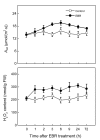Hydrogen peroxide functions as a secondary messenger for brassinosteroids-induced CO2 assimilation and carbohydrate metabolism in Cucumis sativus
- PMID: 23024048
- PMCID: PMC3468824
- DOI: 10.1631/jzus.B1200130
Hydrogen peroxide functions as a secondary messenger for brassinosteroids-induced CO2 assimilation and carbohydrate metabolism in Cucumis sativus
Abstract
Brassinosteroids (BRs) are potent regulators of photosynthesis and crop yield in agricultural crops; however, the mechanism by which BRs increase photosynthesis is not fully understood. Here, we show that foliar application of 24-epibrassinolide (EBR) resulted in increases in CO(2) assimilation, hydrogen peroxide (H(2)O(2)) accumulation, and leaf area in cucumber. H(2)O(2) treatment induced increases in CO(2) assimilation whilst inhibition of the H(2)O(2) accumulation by its generation inhibitor or scavenger completely abolished EBR-induced CO(2) assimilation. Increases of light harvesting due to larger leaf areas in EBR- and H(2)O(2)-treated plants were accompanied by increases in the photochemical efficiency of photosystem II (Φ(PSII)) and photochemical quenching coefficient (q(P)). EBR and H(2)O(2) both activated carboxylation efficiency of ribulose-1,5-bisphosphate oxygenase/carboxylase (Rubisco) from analysis of CO(2) response curve and in vitro measurement of Rubisco activities. Moreover, EBR and H(2)O(2) increased contents of total soluble sugar, sucrose, hexose, and starch, followed by enhanced activities of sugar metabolism such as sucrose phosphate synthase, sucrose synthase, and invertase. Interestingly, expression of transcripts of enzymes involved in starch and sugar utilization were inhibited by EBR and H(2)O(2). However, the effects of EBR on carbohydrate metabolisms were reversed by the H(2)O(2) generation inhibitor diphenyleneodonium (DPI) or scavenger dimethylthiourea (DMTU) pretreatment. All of these results indicate that H(2)O(2) functions as a secondary messenger for EBR-induced CO(2) assimilation and carbohydrate metabolism in cucumber plants. Our study confirms that H(2)O(2) mediates the regulation of photosynthesis by BRs and suggests that EBR and H(2)O(2) regulate Calvin cycle and sugar metabolism via redox signaling and thus increase the photosynthetic potential and yield of crops.
Figures




Similar articles
-
Brassinosteroids promote photosynthesis and growth by enhancing activation of Rubisco and expression of photosynthetic genes in Cucumis sativus.Planta. 2009 Nov;230(6):1185-96. doi: 10.1007/s00425-009-1016-1. Epub 2009 Sep 17. Planta. 2009. PMID: 19760261
-
A role for brassinosteroids in the regulation of photosynthesis in Cucumis sativus.J Exp Bot. 2004 May;55(399):1135-43. doi: 10.1093/jxb/erh124. Epub 2004 Apr 23. J Exp Bot. 2004. PMID: 15107450
-
Cellular glutathione redox homeostasis plays an important role in the brassinosteroid-induced increase in CO2 assimilation in Cucumis sativus.New Phytol. 2012 Jun;194(4):932-943. doi: 10.1111/j.1469-8137.2012.04111.x. Epub 2012 Mar 20. New Phytol. 2012. PMID: 22432590
-
Overexpression of C(4)-cycle enzymes in transgenic C(3) plants: a biotechnological approach to improve C(3)-photosynthesis.J Exp Bot. 2002 Apr;53(369):591-607. doi: 10.1093/jexbot/53.369.591. J Exp Bot. 2002. PMID: 11886879 Review.
-
The circadian regulation of photosynthesis.Photosynth Res. 2014 Feb;119(1-2):181-90. doi: 10.1007/s11120-013-9811-8. Epub 2013 Mar 26. Photosynth Res. 2014. PMID: 23529849 Review.
Cited by
-
Brassinosteroid signaling in plant development and adaptation to stress.Development. 2019 Mar 14;146(5):dev151894. doi: 10.1242/dev.151894. Development. 2019. PMID: 30872266 Free PMC article. Review.
-
Physiological responses of coriander (Coriandrum sativum L.) to exogenous 2,4-epibrassinolide at different concentrations.BMC Plant Biol. 2023 Dec 16;23(1):649. doi: 10.1186/s12870-023-04684-z. BMC Plant Biol. 2023. PMID: 38102554 Free PMC article.
-
Brassinosteroids in Plants: Crosstalk with Small-Molecule Compounds.Biomolecules. 2021 Nov 30;11(12):1800. doi: 10.3390/biom11121800. Biomolecules. 2021. PMID: 34944444 Free PMC article. Review.
-
Brassinosteroids Improve Quality of Summer Tea (Camellia sinensis L.) by Balancing Biosynthesis of Polyphenols and Amino Acids.Front Plant Sci. 2016 Aug 30;7:1304. doi: 10.3389/fpls.2016.01304. eCollection 2016. Front Plant Sci. 2016. PMID: 27625668 Free PMC article.
-
Brassinolide promotes interaction between chloroplasts and mitochondria during the optimization of photosynthesis by the mitochondrial electron transport chain in mesophyll cell protoplasts of Arabidopsis thaliana.Front Plant Sci. 2023 Apr 11;14:1099474. doi: 10.3389/fpls.2023.1099474. eCollection 2023. Front Plant Sci. 2023. PMID: 37113597 Free PMC article.
References
-
- Asami T, Nakano T, Nakashita H, Sekimata K, Shimada Y, Yoshida S. The influence of chemical genetics on plant science: shedding light on functions and mechanism of action of brassinosteroids using biosynthesis inhibitors. J Plant Growth Regul. 2003;22(4):336–349. doi: 10.1007/s00344-003-0065-0. - DOI - PubMed
Publication types
MeSH terms
Substances
LinkOut - more resources
Full Text Sources

